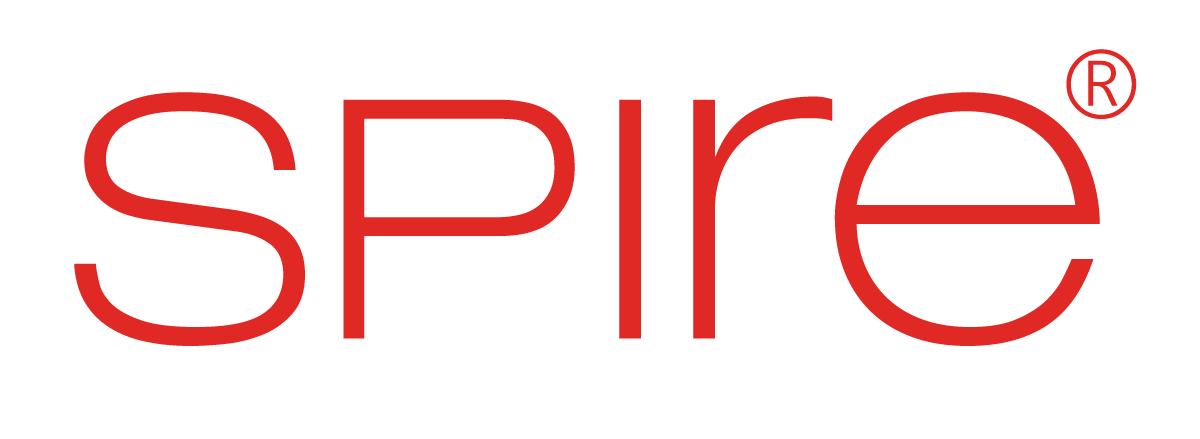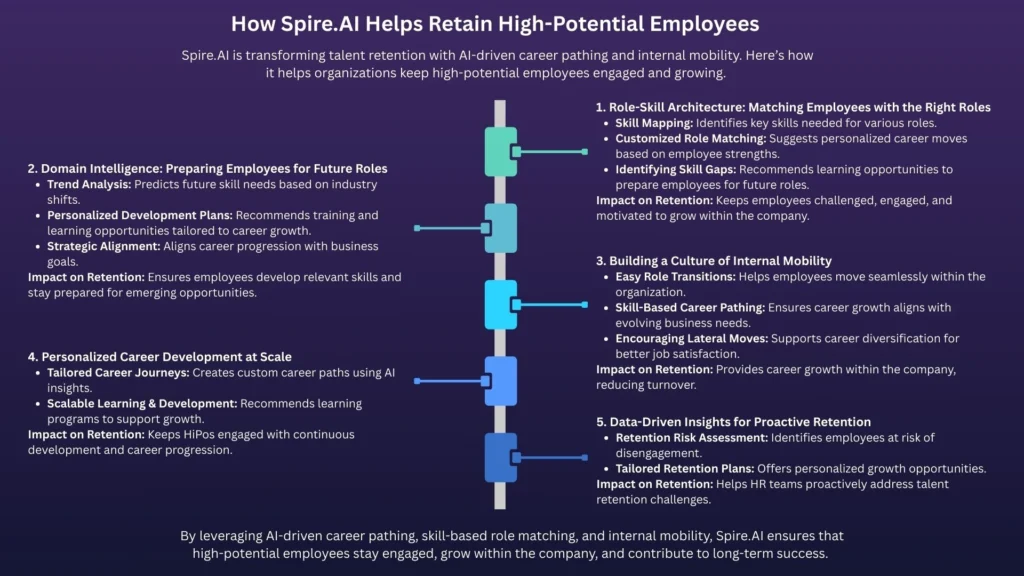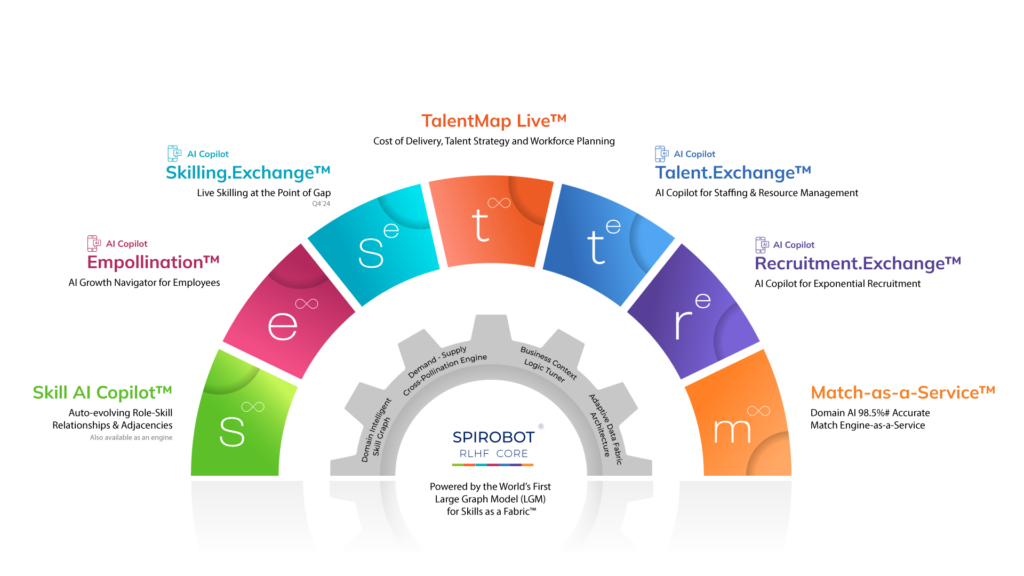Retaining high-potential employees has become a significant challenge for many organizations. While companies invest substantial resources in recruiting and onboarding top talent, the real hurdle lies in keeping them engaged and motivated over the long term. High-potential employees are the driving force behind innovation, leadership in key projects, and the positioning of organizations for future success.
However, research indicates that a significant portion of these employees are not staying. According to a Gallup study, high-potential employees are actively disengaged or considering leaving their current jobs. This issue has become increasingly urgent for HR and talent leaders, particularly in industries where attracting and retaining top-tier talent is vital to sustaining growth.
The problem often stems from a lack of alignment between organizational opportunities and individual career aspirations. Repetitive, uninspiring roles and limited growth prospects are major contributors to employee disengagement. So, how can organizations address these issues and ensure that their high-potential employees remain committed and motivated? The answer lies in personalizing career paths and aligning them with both employee goals and organizational needs.
In this blog, we will highlight how AI-driven solutions like Spire.AI are making it possible to match internal talent with the right opportunities, creating a win-win for both the organization and its employees.
The Importance of Retaining High-Potential Employees
High-potential employees are more than just skilled workers; they are future leaders and key drivers of organizational success. Recognizing and retaining high-potential employees should be a priority for any organization aiming for long-term growth and stability. Here are several key reasons why retaining high-potential employees is so crucial.
Contributing to Strategic Growth and Innovation
High-potential employees bring a unique combination of creativity, critical thinking, and problem-solving abilities that significantly contribute to a company’s innovation and strategic growth. Their fresh ideas drive to innovate help organizations stay ahead of the curve in a competitive market. These employees are often the ones who take on high-stakes projects, bring new perspectives, and pioneer initiatives that move the company closer to achieving its long-term goals.
Building a Strong Pipeline of Future Leaders
High potential employees are typically identified as having the potential to take on leadership roles in the future. Retaining them ensures that the organization has a ready-made pipeline of skilled, capable leaders who can step into key roles as the company grows or as senior positions become available.
The importance of succession planning cannot be overstated. Companies that invest in retaining such employees develop a deeper pool of talent that is already familiar with the organization’s values, culture, and operational processes. According to a 2021 Korn Ferry survey, companies with strong retention strategies for high-potential employees outperform their competitors in terms of revenue and profit growth, largely due to the leadership and vision these employees provide.
By nurturing and retaining these future leaders, companies can avoid the disruptions and challenges that come with externally hiring for leadership roles.
Cost of Employee Turnover
High employee turnover is one of the most significant challenges organizations face. When high-potential employees leave, companies are forced to recruit, hire, and train replacements, a process that can be both time-consuming and costly. Research by the Society for Human Resource Management (SHRM) reveals that the cost of replacing an employee can range from six to nine months of that employee’s salary. For high-potential employees who often hold specialized skills and take on leadership roles, the cost can be even higher.
Beyond direct financial costs, turnover disrupts workflows, impacts team morale, and reduces organizational efficiency. High-potential employees often work on projects that require deep knowledge and continuity, so their departure can leave gaps that affect performance and productivity. Retaining these key employees allows an organization to sidestep these costs, ensuring smoother operations and continuity in strategic initiatives.
Enhancing Employee Engagement and Organizational Culture
When high-potential employees stay with an organization, their loyalty often boosts overall employee engagement. These employees are seen as role models by others, and their commitment to the company can encourage a positive, high-performance culture across the organization.
Moreover, they typically exhibit high levels of job satisfaction, which can be contagious. Their enthusiasm and dedication to the company’s mission can inspire other employees to stay and perform at their best. A stable and engaged workforce leads to higher productivity, lower absenteeism, and improved job satisfaction across the board.
Retention is an Investment in the Company’s Bottom Line
While focusing on retention might seem like a cost to some organizations, it is, in fact, an investment in the company’s long-term success. High turnover, especially among high-potential employees, creates a cycle of perpetual recruitment, hiring, and training, which takes away valuable resources from the company. When organizations invest in keeping high-potential employees, they are not only saving the direct costs of turnover but are also setting themselves up for more consistent and sustainable growth.
Moreover, the cost of lost productivity due to turnover is significant. When experienced employees leave, the knowledge they take with them also departs. This can slow down projects, reduce efficiency, and disrupt team dynamics. Conversely, retaining high-potential employees helps companies maintain high levels of productivity, continuity, and morale.
Creating Competitive Advantage
Finally, companies that can consistently retain high-potential employees build a distinct competitive advantage. Organizations with strong retention strategies and a solid group of engaged, talented employes are often more agile, responsive, and innovative than their competitors. They are better positioned to capitalize on opportunities, mitigate risks, and stay ahead of market trends.
For example, in industries where the war for talent is fierce, retaining high-potential employees not only helps organizations maintain stability but also allows them to attract more talent. A reputation for supporting and developing high-potential employees creates a positive feedback loop where talented professionals are drawn to the company because they know it values career growth and personal development.
The Causes of Employee Disengagement
High-potential employees are a critical asset to organizations, but without the right environment and opportunities for growth, they are often at risk of disengagement. Disengagement happens when employees feel disconnected from their work, their role, and their potential for career advancement. For high-potential employees, the lack of alignment between their day-to-day tasks and their long-term career goals can lead to frustration, burnout, and ultimately, turnover. Let’s explore in more detail the key causes of disengagement among high-potential employees.
Lack of Alignment Between Role and Career Goals
The primary driver of disengagement for many high-potential employees is the absence of alignment between the work they do and their long-term career aspirations. High-potential employees are typically ambitious, driven by the desire to develop their skills, take on new challenges, and advance in their careers. When organizations do not provide opportunities that allow high-potential employees to grow and expand their abilities, they quickly begin to feel stagnant.
When an employee’s current role no longer aligns with their professional goals, they become disengaged. For instance, an employee in a leadership track may find themselves stuck in a role that focuses primarily on repetitive tasks with no room for innovation, decision-making, or team leadership.
As a result, they begin to lose motivation because their work doesn’t offer the growth they seek. High-potential employees are looking for roles that stretch their abilities, challenge them, and contribute to their development. Without these opportunities, they feel that they are not progressing in their careers, which can ultimately lead them to look for opportunities elsewhere.
Repetitive and Stagnant Roles
Another significant cause of disengagement is being stuck in a role that feels repetitive and lacks variation. While most employees want consistency in their job, high-potential employees thrive on variety, complexity, and the opportunity to tackle new challenges. If they are assigned the same set of tasks every day without the chance to grow in their role or explore new areas of responsibility, they can quickly become bored and frustrated.
Repetitive tasks can make an employee feel like they are merely “checking off boxes” rather than actively contributing to their team or organization’s strategic goals. For high-potential employees, this feeling of stagnation can be particularly disheartening, as it signals that they are not being challenged or trusted with more significant responsibilities. When these employees perceive that they have hit a plateau in their roles, they may start to disengage, which could result in them exploring other opportunities where they can grow.
Limited Growth Opportunities
Organizations that fail to offer continuous challenges and opportunities for skill development create an environment where high-potential employees feel they have no room to advance. According to a LinkedIn survey, 94% of employees would stay longer at a company if it invested in their career development. High-potential employees are generally self-motivated and eager to learn and develop their skillset. They want to work in environments where they can continue to improve and take on more responsibility.
When an organization fails to provide access to training programs, mentorship, cross-functional projects, or leadership development opportunities, high-potential employees begin to feel their professional growth is stunted. Over time, this lack of investment in their personal and professional development leads them to question their future with the company.
If employees do not see a clear path for advancement or opportunities to acquire new skills, they may seek positions elsewhere that promise better growth prospects.
Unclear or Generic Career Progression Models
One of the most significant pitfalls for many organizations is relying on generic, one-size-fits-all career progression models. These models may work well for entry-level employees, but they do not account for the unique strengths, aspirations, and potential of high-potential employees. A high-potential employee might find themselves following a rigid and predefined path that doesn’t align with their specific career goals or ambitions. This lack of personalization can result in frustration and disengagement.
Lack of Autonomy and Empowerment
High-potential employees tend to be independent, innovative, and driven. They want to be empowered to take ownership of their work, contribute their ideas, and lead projects. However, if they are micromanaged or given limited autonomy in their role, they can quickly feel frustrated. This lack of trust and freedom can cause them to disengage, as they perceive that their talents and abilities are being underutilized.
Organizations that empower high-potential employees to take on challenging projects, make decisions, and lead initiatives can foster higher levels of engagement. When these employees feel trusted and supported, they are more likely to remain motivated and committed to the company. However, when autonomy is restricted, the opposite effect occurs: employees feel constrained and begin to look for environments where they can contribute more freely.
The Solution: Personalized Career Paths
In order to retain high-potential employees, organizations must go beyond traditional career development frameworks and embrace personalized career paths that align with both individual aspirations and the company’s needs.
Unlike the standard, one-size-fits-all career progression models that often fail to engage top talent, personalized career paths provide employees with opportunities that match their skills, interests, and long-term goals. This approach not only enhances employee satisfaction and engagement but also strengthens retention, ensuring that organizations are able to fully leverage their employees’ potential.
Tailoring Career Development to Individual Needs
Personalized career paths are built upon the premise that each employee is unique, with specific skills, experiences, and career goals. One of the most effective ways to craft these paths is by understanding the individual’s career ambitions, strengths, and areas of improvement. Personalized career development plans allow organizations to align opportunities with the specific desires and capabilities of their employees, fostering a sense of ownership over their career journey.
Mentorship Programs and Cross-Functional Projects
Mentorship programs are another key component of personalized career paths. These programs provide high-potential employees with the opportunity to learn from experienced leaders within the organization, offering valuable insights, feedback, and guidance as they work towards their professional goals. A well-designed mentorship program can foster deeper relationships between employees and leadership, helping to identify potential future leaders within the organization.
In addition to mentorship, cross-functional projects also play a crucial role in developing high-potential employees. By exposing them to different departments, teams, and projects, organizations can help high-potential employees develop a broader skill set and gain valuable experience that can be applied to their future roles. These projects also enable high-potential employees to see the bigger picture, helping them better understand how their contributions fit into the organization’s overall strategy.
Stretch Assignments and Leadership Training
Stretch assignments are another way to offer personalized career paths to HiPos. These assignments involve giving employees challenging projects or tasks that push them outside their comfort zones, enabling them to develop new skills and grow professionally. For example, assigning an employee to lead a cross-departmental initiative or manage a high-profile project can provide them with invaluable leadership experience while simultaneously helping the company achieve its goals.
Leadership training is also an essential element of personalized career development. By investing in leadership development programs, organizations can help high-potential employees acquire the skills they need to take on more senior roles in the future. According to a 2021 report by Deloitte, 87% of executives rated leadership development as a top priority for their organizations. High-potential employees are typically looking for opportunities to step into leadership roles, so providing them with the training and resources they need to succeed in these positions is critical for their long-term engagement and retention.
Continuous Feedback and Skill Development
Personalized career paths also involve ongoing feedback and skill development. High-potential employees thrive when they receive regular, constructive feedback that helps them improve and grow. This feedback should not be limited to annual performance reviews but should be integrated into regular check-ins and real-time evaluations. This allows high-potential employees to continuously adjust their performance, build on their strengths, and work on areas that need improvement.
Additionally, skill development is a crucial part of any personalized career path. High-potential employees are often looking for opportunities to acquire new skills or deepen their expertise. By offering tailored learning and development programs that align with the employee’s goals, companies can help their top talent stay competitive and engaged.
Employees said they would stay longer at a company that provides them with learning and development opportunities. By investing in skill development programs, organizations not only enhance employee engagement but also create a more skilled and versatile workforce.
Leveraging AI to Scale Personalized Career Paths
While creating personalized career paths requires a tailored approach and a deep understanding of employee needs, artificial intelligence (AI) can help scale this process across the organization. AI-driven platforms can analyze vast amounts of employee data, including skills, experiences, performance reviews, and career aspirations, to make data-driven recommendations about which roles and opportunities are the best fit for each employee.
These AI platforms use Role-Skill Architecture, Domain AI and Large Graph Model (LGM) for Skills to assess skill gaps, identify potential growth opportunities, and predict career trajectories. For example, AI can match high-potential employees with stretch assignments, new roles, or learning programs that will accelerate their development. By offering recommendations based on data-driven insights, AI helps to ensure that each employee receives the right opportunities at the right time.
Moreover, AI can also help HR and talent leaders track employee progress over time, making it easier to evaluate whether employees are receiving the support and resources they need to succeed in their personalized career paths. This technology empowers organizations to proactively address any issues or challenges that may arise, ensuring that high-potential employees stay engaged and on track.
Driving Employee Retention through Personalization
Personalized career paths have been shown to significantly improve employee retention. When employees feel that their career development is being prioritized and that their individual goals are being recognized, they are more likely to remain loyal to the organization.
A Gallup study found that employees who strongly agree that their employer cares about their development are more likely to be engaged and likely to stay at their company long term.
For high-potential employees, the opportunity for growth and advancement is a critical factor in their decision to stay with an organization. By offering personalized career paths, companies can create an environment where high-potential employees feel valued, challenged, and supported in their journey. This not only improves retention rates but also strengthens the organization’s overall talent strategy by ensuring that top performers continue to grow and take on higher levels of responsibility.
AI-Driven Platforms for Scaling Career Path Personalization
Platforms like Spire.AI are an example of how AI can be leveraged to build and scale personalized career paths across an organization. Spire.AI uses Role-Skill Architecture and Domain Intelligence to match employees with the most appropriate roles, training, and development opportunities based on their skills, career goals, and potential.
The platform’s role-skill architecture helps organizations map out the skills required for various roles, while Domain Intelligence provides insight into the skills employees need to develop in order to transition into higher roles or different departments. By using Domain-AI to analyze employee data, Spire.AI makes it possible for organizations to create personalized, data-driven career development paths that cater to each employee’s individual strengths and aspirations.
The Role of Internal Talent Mobility
Internal talent mobility is another essential factor in retaining high-potential employees. Offering employees the opportunity to explore different roles within the organization not only keeps them engaged but also helps organizations retain their top talent and fill critical roles faster. According to a report by Gallup, companies with strong internal mobility programs have higher engagement levels that those without.
Employees often leave because they feel that their current role offers no room for advancement. However, if they are allowed to move to different roles within the organization that better align with their evolving skills and career goals, they are more likely to stay. Internal mobility programs can also help organizations reduce the time and costs associated with recruiting externally.
AI-powered platforms like Spire.AI can enable organizations to implement internal talent mobility effectively. This platform use Role-Skill Architecture and Domain Intelligence to match employees with roles that suit their skillset and career aspirations. This approach not only accelerates employee development but also helps organizations retain their most valuable employees by offering them the right opportunities at the right time.
One of the key benefits of using Spire.AI is that it helps organizations build a culture of internal mobility. When employees see that they can grow and evolve within the company, they are more likely to stay and contribute to the organization’s success. Spire.AI helps create this culture by ensuring that internal opportunities are not just available but tailored to individual career aspirations, which encourages employees to stay engaged and take charge of their career progression.
A strong internal mobility culture can also contribute to higher employee morale and job satisfaction, as employees feel empowered and supported in their professional growth. In fact, a study by LinkedIn found that companies with strong internal mobility practices report 41% higher employee retention. When employees are given the freedom to explore different roles and grow within the company, they are more likely to stay long-term, reducing the high costs of turnover and recruitment.
How Spire.AI Helps Retain High-Potential Employees
Spire.AI is a transformative AI-driven platform designed to tackle one of the most pressing challenges organizations face today: retaining high-potential employees. By utilizing advanced technologies like Role-Skill Architecture and Domain Intelligence, Spire.AI enables companies to create personalized career paths for their top talent, foster internal mobility, and offer continuous learning opportunities that align with both the needs of the employees and the organization.
Let’s break down how these two solutions work together to retain high-potential employees and drive long-term organizational success.
Role-Skill Architecture: Aligning Employees with the Right Roles
One of the core features of Spire.AI is its Role-Skill Architecture, which helps organizations map out the key skills required for various roles within the organization. The platform categorizes roles and defines the skills that are essential for success in those positions. This approach enables HR and talent teams to match employees with roles that not only align with their current abilities but also offer growth opportunities for the future.
How Role-Skill Architecture Works?
- Skill Mapping: Spire.AI first maps out the specific skills needed for each role, whether it’s leadership, technical expertise, or cross-functional collaboration. It then compares these role requirements with the skillsets of current employees to determine which roles are the best fit.
- Customized Role Matching: When high-potential employees are considering career progression, Spire.AI offers personalized suggestions for roles that align with their strengths and current skill levels. This personalized role matching ensures that employees are continually challenged but not overwhelmed, keeping them engaged and motivated.
- Identifying Skill Gaps: The platform also identifies the skill gaps that prevent employees from stepping into more advanced roles. By highlighting these gaps, Spire.AI recommends learning and development opportunities, ensuring employees have the tools they need to progress within the organization.
Impact on Retention: This approach not only helps employees find roles that suit their existing capabilities but also challenges them to grow, offering a continuous path of professional development. The result is higher engagement and a reduced likelihood that high-potential employees will leave for external opportunities that offer greater career advancement.
Domain Intelligence: Preparing Employees for Future Roles
Spire.AI’s Domain Intelligence is another critical component of its strategy to retain high-potential employees. This solution helps organizations anticipate future skill needs and trends, ensuring that employees are prepared for the roles of tomorrow.
How Domain Intelligence Works?
- Current and Emerging Trends: Spire.AI analyzes both current trends within the organization and emerging industry shifts to predict future skill requirements. For example, as automation and artificial intelligence continue to evolve, Spire.AI can identify the skills employees need to stay competitive, and recommend relevant learning opportunities.
- Personalized Development Recommendations: Based on the employee’s current role, skills, and career aspirations, Spire.AI generates personalized development plans. These plans may include targeted learning programs, certifications, or exposure to new projects that align with both the employee’s goals and the organization’s strategic direction.
- Strategic Alignment: By aligning the development of employees with the organization’s long-term goals, Domain Intelligence helps ensure that high-potential employees are working toward roles that are critical to the business’s future success.
For example, as the company shifts to digital transformation, Domain Intelligence can identify employees with leadership potential in this area and recommend them with learning opportunities to step into leadership roles within the digital division.
Impact on Retention: By preparing employees for future roles and ensuring they have the skills to meet emerging business needs, Domain Intelligence helps organizations retain high-potential employees who are eager to grow. This proactive approach to career development enhances employee satisfaction and loyalty, reducing the likelihood of turnover.
Building a Culture of Internal Mobility
Spire.AI’s integration of Role-Skill Architecture and Domain Intelligence does more than just match employees with roles, it creates a culture of internal mobility. Internal mobility is one of the most effective ways to keep employees engaged and motivated, as it enables them to explore new challenges and advance their careers without leaving the organization.
How Spire.AI Supports Internal Mobility?
- Easy Role Transitions: Spire.AI makes it easier for employees to move within the organization by identifying open roles that match their skills and aspirations. For example, an employee in one department who has developed new skills through training may be easily transitioned to a different department, fostering cross-functional collaboration and growth.
- Skill-Based Career Pathing: The AI platform ensures that internal mobility is skill-based and strategic. It not only matches employees with roles they are ready for but also ensures that these roles align with the business’s evolving needs. This results in more informed, sustainable career transitions that benefit both the employee and the organization.
- Encouraging Lateral Moves: Internal mobility is not just about promotions; it also includes lateral moves that allow employees to explore different aspects of the business. By offering such opportunities, Spire.AI helps employees find the roles that best align with their evolving interests and capabilities, improving their overall job satisfaction.
Impact on Retention: By encouraging internal mobility, Spire.AI ensures that employees see the organization as a place where they can grow and advance. This reduces the likelihood that high-potential employees will seek new opportunities externally, as they can achieve their career goals within the company.
Personalized Career Development at Scale
Spire.AI’s combination of Role-Skill Architecture and Domain Intelligence enables organizations to offer personalized career development at scale. In large organizations, it can be difficult to create individualized career paths for every employee, but Spire.AI makes it possible by automating the process of career mapping and skill development.
How Personalized Development Works at Scale?
- Tailored Career Journeys: Each employee’s career journey is personalized based on their individual strengths, goals, and the skills they need to develop. Spire.AI uses Domain-AI to analyze an employee’s historical performance, skill sets, and career preferences to create a clear, data-driven path for their future development.
- Scalable Learning and Development: Spire.AI can recommend learning programs, training opportunities, and skill-building exercises that are tailored to each employee’s needs. This allows organizations to offer continuous learning opportunities to all employees, ensuring they are always developing the skills necessary to take on new challenges.
Impact on Retention: Personalized development ensures that high-potential employees are always being challenged and developed in ways that align with both their individual career goals and the company’s needs. By fostering a culture of continuous development, Spire.AI helps ensure that top talent remains engaged and committed to the organization.
Enhanced Data-Driven Insights for Retention Strategy
Spire.AI also provides organizations with data-driven insights that allow HR teams to make more informed decisions about how to retain high-potential employees. By collecting and analyzing data on employee performance, engagement, and development progress, Spire.AI helps identify trends, gaps, and areas for improvement in retention strategies.
How Data-Driven Insights Work?
- Retention Risk Assessment: Spire.AI helps organizations identify high-potential employees who may be at risk of disengagement or departure. The platform’s predictive analytics can flag early warning signs such as a lack of development opportunities or a mismatch between an employee’s skills and their current role.
- Tailored Retention Plans: Using this data, HR teams can create targeted retention plans for high-potential employees, offering them specific opportunities for growth, development, or new challenges that are more aligned with their aspirations.
Impact on Retention: By using data-driven insights, organizations can proactively address retention risks, ensuring that high-potential employees stay engaged and feel supported throughout their career journey.
Conclusion: The Future of Employee Retention
As the workforce becomes more dynamic and competitive, organizations must prioritize the retention of high-potential employees. Personalizing career paths, leveraging AI for tailored development, and implementing internal talent mobility programs are key strategies to keep high-potential employees engaged and committed to their organization.
Organizations that fail to address the unique career aspirations of their top talent risk losing them to competitors who offer more aligned opportunities. The role of AI in talent management, particularly platforms like Spire.AI, has become indispensable in creating these personalized career paths and ensuring that high-potential employees are continuously engaged, developed, and retained.
In an increasingly competitive job market, it is clear: organizations that invest in their employees’ growth and align opportunities with their potential will be the ones who not only attract top talent but retain them for the long term.







